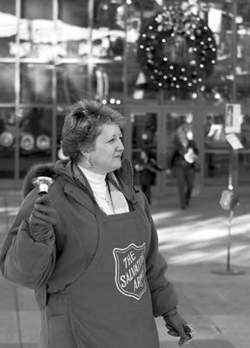Salvation Army
http://www1.salvationarmy.org/
Salvation Army
(religion, spiritualism, and occult)Within half an hour of the September 11, 2001, terrorist attack on the World Trade Center in New York, some 200 officers of the Salvation Army were on hand, offering coffee and hot meals, clothes, teddy bears to comfort children, and words of prayer and encouragement to anyone who needed them. The Salvation Army set up shop in more than twenty-four buildings, almost one million square feet of valuable Manhattan commercial space. Hundreds of trucks poured in and out of the city carrying sandwiches, hot dogs, food, water, and even eye drops. Every one of them bore the familiar logo of the Salvation Army, the same logo painted on the kettles that appear every Christmas in local shopping malls. No one will ever know for sure, but this effort may well go down as one of the greatest, most efficient, and most appreciated charity endeavors ever held on American soil. The current leader of this $2.1 billion organization is a man by the name of Todd Bassett. He makes $13,000 a year. (To put this in perspective, Marsha Evans, CEO of the American Red Cross, made $450,000 in 2002.) According to the latest U.S. figures, that's poverty level. And his worldwide staff doesn't do any better. Obviously they're not in it for the money. They are committed Christians. The Salvation Army is a Christian church. Attend a worship service held in the auditorium of the Salvation Army building in your town and you will come away thinking you've just attended an evangelical Protestant church service. And you have. They are in the business of saving souls. That's where the "Salvation" part of the name comes from. The "Army" part comes from the fact that they are organized along the same lines as the military. The person who runs a local Salvation Army is probably called "Captain" or "Lieutenant," not Reverend.
But what makes the Salvation Army unique is that William Booth, its Methodist founder, believed way back in 1865 that you couldn't talk to someone about Christ if his or her stomach was growling. He decided to minister to the teeming denizens of London's slums, offering them "soup, soap, and salvation."
Thirty-five years later the movement jumped across the Atlantic, setting up shop in New York City's Battery Park. After that, it was only a matter of time and effort.
When a hurricane devastated Galveston, Texas, in 1900, the Salvation Army was there. Since then its members have offered assistance at every national tragedy and most neighborhood fires, answering the call for major disasters and for knocks on their door in the dead of night.
You may think they only appear during the holidays. You may even resent their very visible presence as volunteers ring bells, asking for donations during the busy shopping days before Christmas. But their records and statistics are public knowledge. There's no gimmick and no hidden agenda. They do it because they believe in their ministry.
